HI6005 Research: Management, Globalisation & Culture Analysis
VerifiedAdded on 2023/06/16
|5
|1727
|300
Report
AI Summary
This research paper delves into Thomas Friedman's concept of the 'Flat World,' examining its benefits and drawbacks, including the collision of ideas and the potential for exploitation. It also explores the definition of culture, both generally and within organizations, highlighting the role of organizational culture in shaping values and behaviours. The paper discusses the dynamic nature of organizational culture and how it varies due to differing cultural backgrounds. It concludes that while the definition of organizational culture may differ, its role in protecting and advancing the organization remains consistent, imagination and innovation are key factors in surviving in a flat world. Desklib offers a platform to access this paper and many other resources for students.
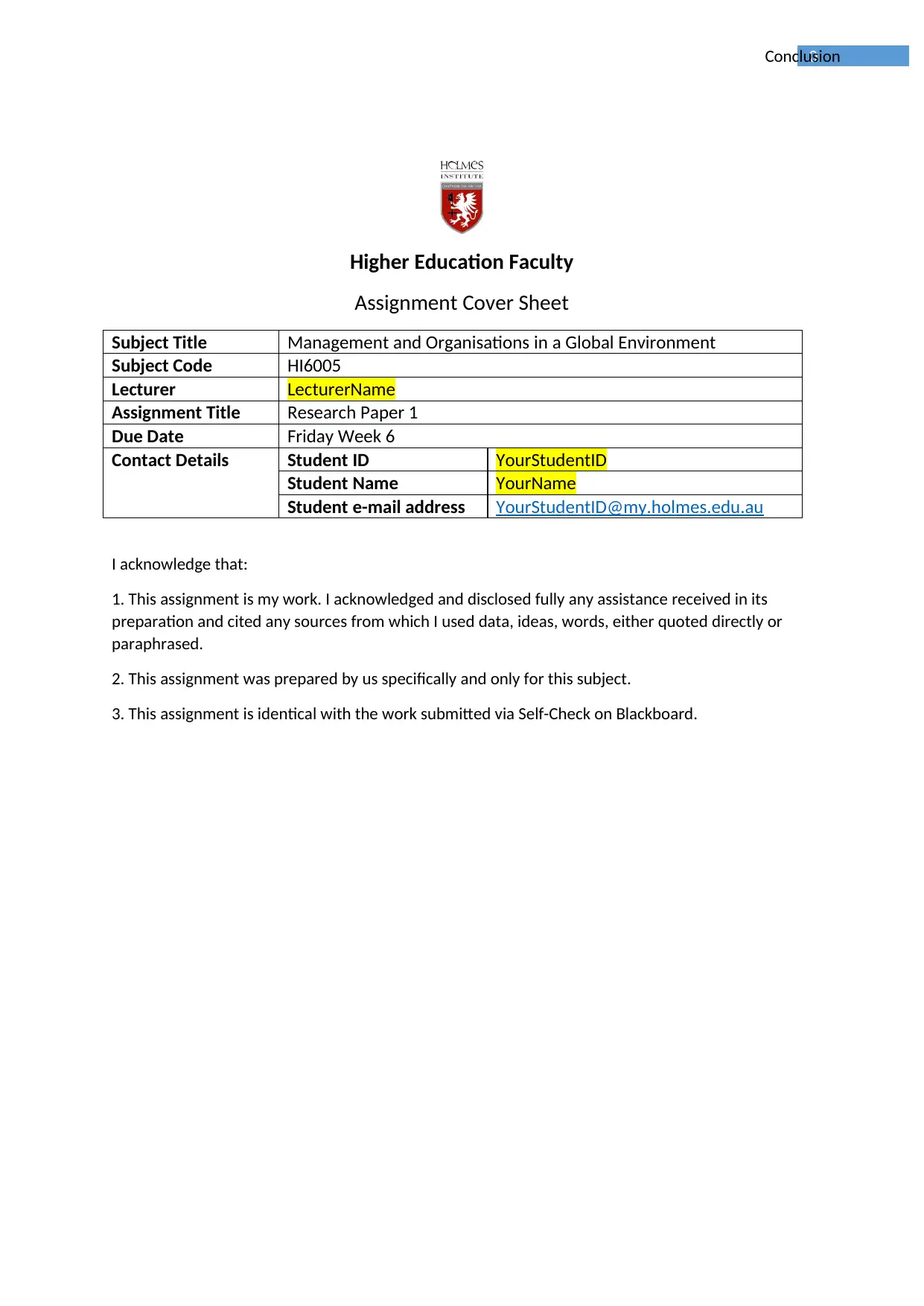
0Conclusion
Higher Education Faculty
Assignment Cover Sheet
Subject Title Management and Organisations in a Global Environment
Subject Code HI6005
Lecturer LecturerName
Assignment Title Research Paper 1
Due Date Friday Week 6
Contact Details Student ID YourStudentID
Student Name YourName
Student e-mail address YourStudentID@my.holmes.edu.au
I acknowledge that:
1. This assignment is my work. I acknowledged and disclosed fully any assistance received in its
preparation and cited any sources from which I used data, ideas, words, either quoted directly or
paraphrased.
2. This assignment was prepared by us specifically and only for this subject.
3. This assignment is identical with the work submitted via Self-Check on Blackboard.
Higher Education Faculty
Assignment Cover Sheet
Subject Title Management and Organisations in a Global Environment
Subject Code HI6005
Lecturer LecturerName
Assignment Title Research Paper 1
Due Date Friday Week 6
Contact Details Student ID YourStudentID
Student Name YourName
Student e-mail address YourStudentID@my.holmes.edu.au
I acknowledge that:
1. This assignment is my work. I acknowledged and disclosed fully any assistance received in its
preparation and cited any sources from which I used data, ideas, words, either quoted directly or
paraphrased.
2. This assignment was prepared by us specifically and only for this subject.
3. This assignment is identical with the work submitted via Self-Check on Blackboard.
Paraphrase This Document
Need a fresh take? Get an instant paraphrase of this document with our AI Paraphraser
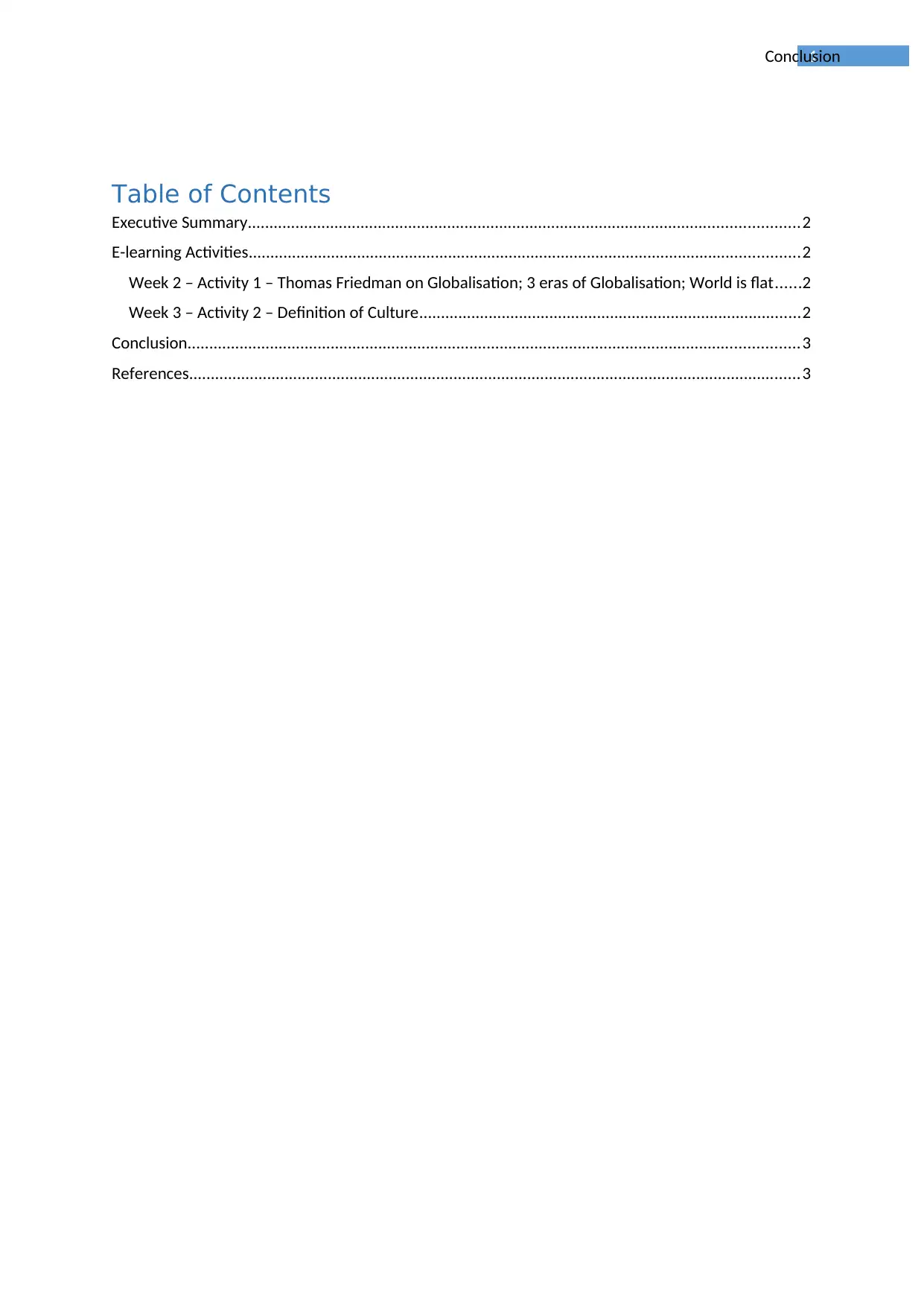
1Conclusion
Table of Contents
Executive Summary...............................................................................................................................2
E-learning Activities...............................................................................................................................2
Week 2 – Activity 1 – Thomas Friedman on Globalisation; 3 eras of Globalisation; World is flat......2
Week 3 – Activity 2 – Definition of Culture........................................................................................2
Conclusion.............................................................................................................................................3
References.............................................................................................................................................3
Table of Contents
Executive Summary...............................................................................................................................2
E-learning Activities...............................................................................................................................2
Week 2 – Activity 1 – Thomas Friedman on Globalisation; 3 eras of Globalisation; World is flat......2
Week 3 – Activity 2 – Definition of Culture........................................................................................2
Conclusion.............................................................................................................................................3
References.............................................................................................................................................3
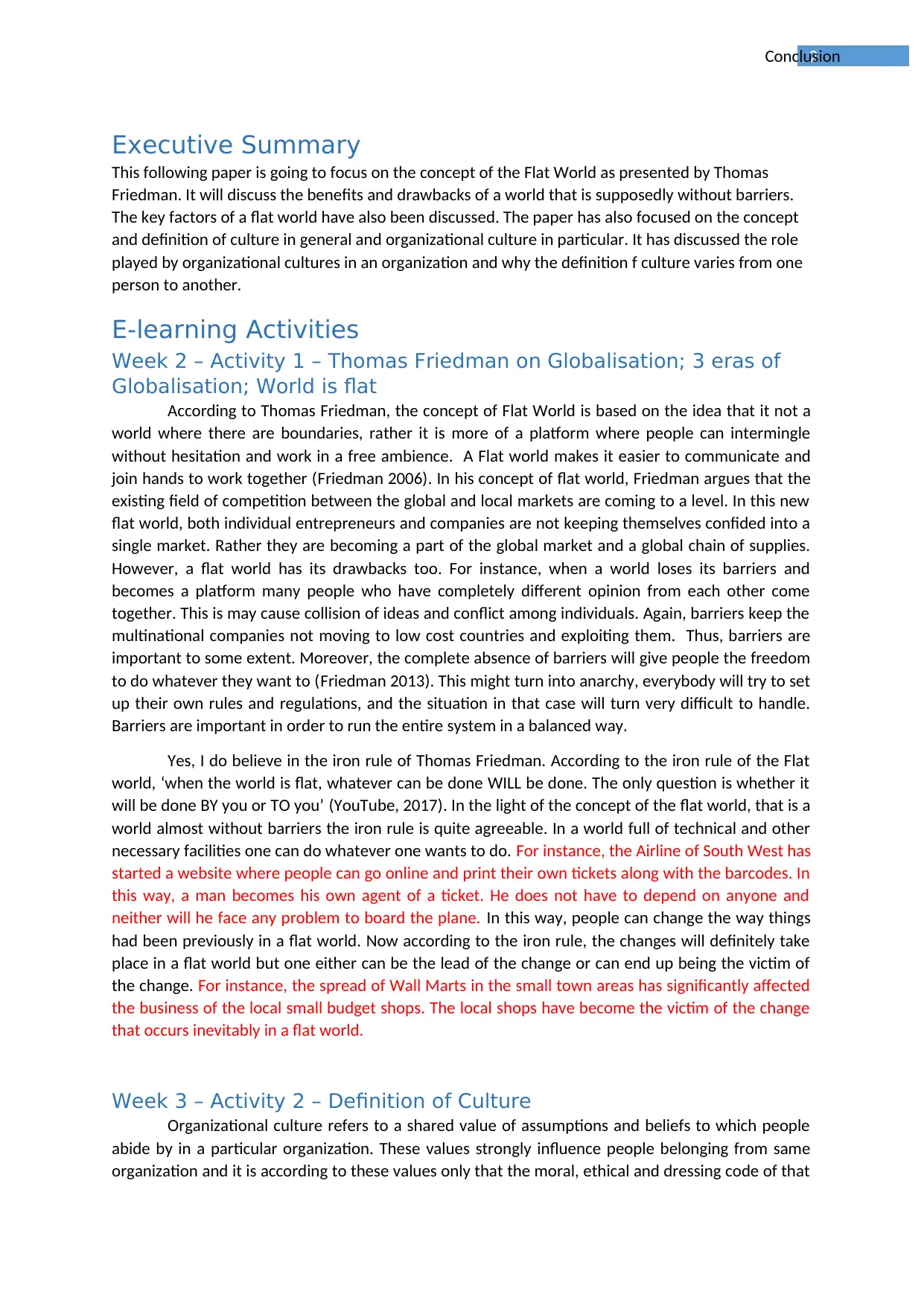
2Conclusion
Executive Summary
This following paper is going to focus on the concept of the Flat World as presented by Thomas
Friedman. It will discuss the benefits and drawbacks of a world that is supposedly without barriers.
The key factors of a flat world have also been discussed. The paper has also focused on the concept
and definition of culture in general and organizational culture in particular. It has discussed the role
played by organizational cultures in an organization and why the definition f culture varies from one
person to another.
E-learning Activities
Week 2 – Activity 1 – Thomas Friedman on Globalisation; 3 eras of
Globalisation; World is flat
According to Thomas Friedman, the concept of Flat World is based on the idea that it not a
world where there are boundaries, rather it is more of a platform where people can intermingle
without hesitation and work in a free ambience. A Flat world makes it easier to communicate and
join hands to work together (Friedman 2006). In his concept of flat world, Friedman argues that the
existing field of competition between the global and local markets are coming to a level. In this new
flat world, both individual entrepreneurs and companies are not keeping themselves confided into a
single market. Rather they are becoming a part of the global market and a global chain of supplies.
However, a flat world has its drawbacks too. For instance, when a world loses its barriers and
becomes a platform many people who have completely different opinion from each other come
together. This is may cause collision of ideas and conflict among individuals. Again, barriers keep the
multinational companies not moving to low cost countries and exploiting them. Thus, barriers are
important to some extent. Moreover, the complete absence of barriers will give people the freedom
to do whatever they want to (Friedman 2013). This might turn into anarchy, everybody will try to set
up their own rules and regulations, and the situation in that case will turn very difficult to handle.
Barriers are important in order to run the entire system in a balanced way.
Yes, I do believe in the iron rule of Thomas Friedman. According to the iron rule of the Flat
world, ‘when the world is flat, whatever can be done WILL be done. The only question is whether it
will be done BY you or TO you’ (YouTube, 2017). In the light of the concept of the flat world, that is a
world almost without barriers the iron rule is quite agreeable. In a world full of technical and other
necessary facilities one can do whatever one wants to do. For instance, the Airline of South West has
started a website where people can go online and print their own tickets along with the barcodes. In
this way, a man becomes his own agent of a ticket. He does not have to depend on anyone and
neither will he face any problem to board the plane. In this way, people can change the way things
had been previously in a flat world. Now according to the iron rule, the changes will definitely take
place in a flat world but one either can be the lead of the change or can end up being the victim of
the change. For instance, the spread of Wall Marts in the small town areas has significantly affected
the business of the local small budget shops. The local shops have become the victim of the change
that occurs inevitably in a flat world.
Week 3 – Activity 2 – Definition of Culture
Organizational culture refers to a shared value of assumptions and beliefs to which people
abide by in a particular organization. These values strongly influence people belonging from same
organization and it is according to these values only that the moral, ethical and dressing code of that
Executive Summary
This following paper is going to focus on the concept of the Flat World as presented by Thomas
Friedman. It will discuss the benefits and drawbacks of a world that is supposedly without barriers.
The key factors of a flat world have also been discussed. The paper has also focused on the concept
and definition of culture in general and organizational culture in particular. It has discussed the role
played by organizational cultures in an organization and why the definition f culture varies from one
person to another.
E-learning Activities
Week 2 – Activity 1 – Thomas Friedman on Globalisation; 3 eras of
Globalisation; World is flat
According to Thomas Friedman, the concept of Flat World is based on the idea that it not a
world where there are boundaries, rather it is more of a platform where people can intermingle
without hesitation and work in a free ambience. A Flat world makes it easier to communicate and
join hands to work together (Friedman 2006). In his concept of flat world, Friedman argues that the
existing field of competition between the global and local markets are coming to a level. In this new
flat world, both individual entrepreneurs and companies are not keeping themselves confided into a
single market. Rather they are becoming a part of the global market and a global chain of supplies.
However, a flat world has its drawbacks too. For instance, when a world loses its barriers and
becomes a platform many people who have completely different opinion from each other come
together. This is may cause collision of ideas and conflict among individuals. Again, barriers keep the
multinational companies not moving to low cost countries and exploiting them. Thus, barriers are
important to some extent. Moreover, the complete absence of barriers will give people the freedom
to do whatever they want to (Friedman 2013). This might turn into anarchy, everybody will try to set
up their own rules and regulations, and the situation in that case will turn very difficult to handle.
Barriers are important in order to run the entire system in a balanced way.
Yes, I do believe in the iron rule of Thomas Friedman. According to the iron rule of the Flat
world, ‘when the world is flat, whatever can be done WILL be done. The only question is whether it
will be done BY you or TO you’ (YouTube, 2017). In the light of the concept of the flat world, that is a
world almost without barriers the iron rule is quite agreeable. In a world full of technical and other
necessary facilities one can do whatever one wants to do. For instance, the Airline of South West has
started a website where people can go online and print their own tickets along with the barcodes. In
this way, a man becomes his own agent of a ticket. He does not have to depend on anyone and
neither will he face any problem to board the plane. In this way, people can change the way things
had been previously in a flat world. Now according to the iron rule, the changes will definitely take
place in a flat world but one either can be the lead of the change or can end up being the victim of
the change. For instance, the spread of Wall Marts in the small town areas has significantly affected
the business of the local small budget shops. The local shops have become the victim of the change
that occurs inevitably in a flat world.
Week 3 – Activity 2 – Definition of Culture
Organizational culture refers to a shared value of assumptions and beliefs to which people
abide by in a particular organization. These values strongly influence people belonging from same
organization and it is according to these values only that the moral, ethical and dressing code of that
⊘ This is a preview!⊘
Do you want full access?
Subscribe today to unlock all pages.

Trusted by 1+ million students worldwide
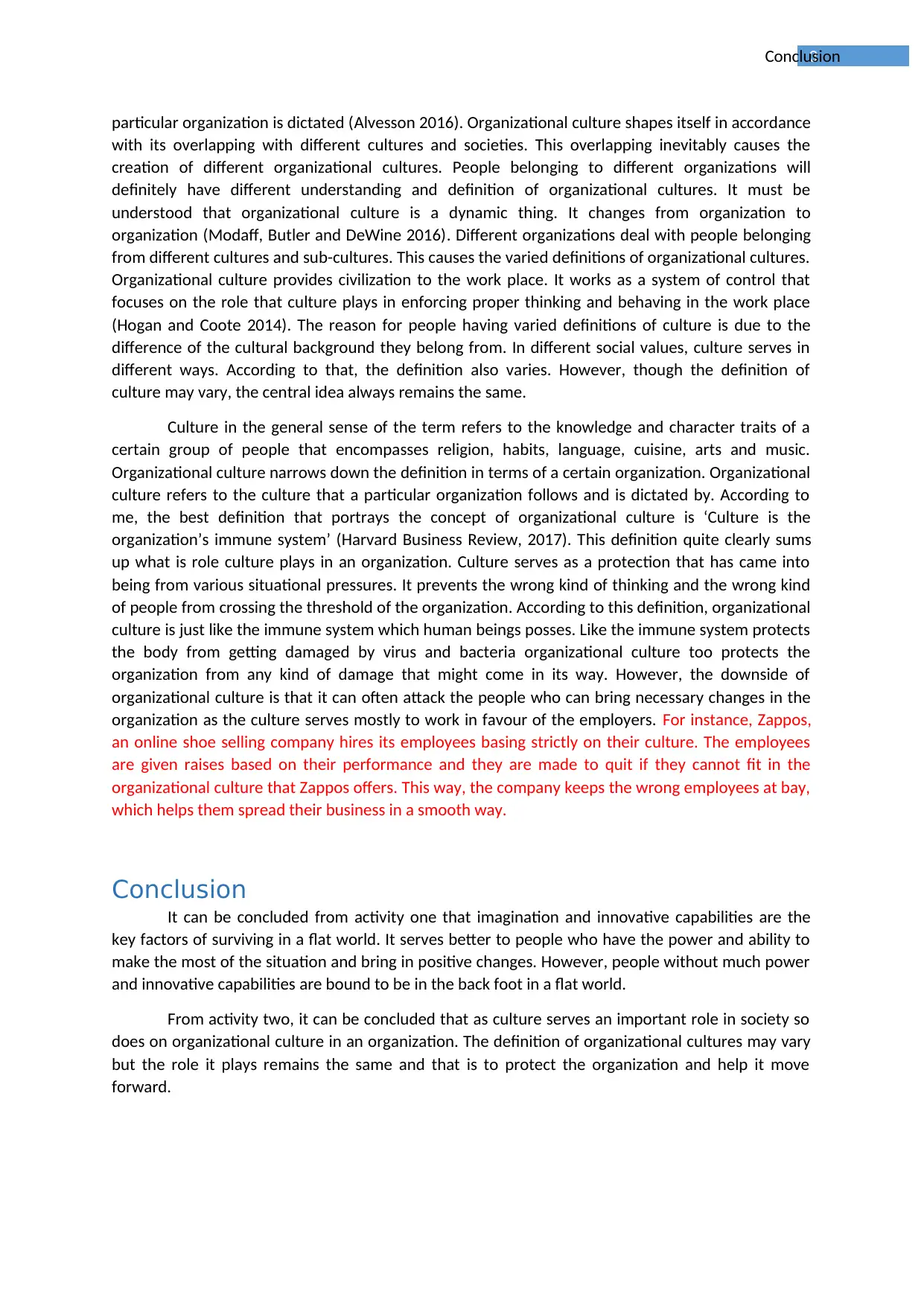
3Conclusion
particular organization is dictated (Alvesson 2016). Organizational culture shapes itself in accordance
with its overlapping with different cultures and societies. This overlapping inevitably causes the
creation of different organizational cultures. People belonging to different organizations will
definitely have different understanding and definition of organizational cultures. It must be
understood that organizational culture is a dynamic thing. It changes from organization to
organization (Modaff, Butler and DeWine 2016). Different organizations deal with people belonging
from different cultures and sub-cultures. This causes the varied definitions of organizational cultures.
Organizational culture provides civilization to the work place. It works as a system of control that
focuses on the role that culture plays in enforcing proper thinking and behaving in the work place
(Hogan and Coote 2014). The reason for people having varied definitions of culture is due to the
difference of the cultural background they belong from. In different social values, culture serves in
different ways. According to that, the definition also varies. However, though the definition of
culture may vary, the central idea always remains the same.
Culture in the general sense of the term refers to the knowledge and character traits of a
certain group of people that encompasses religion, habits, language, cuisine, arts and music.
Organizational culture narrows down the definition in terms of a certain organization. Organizational
culture refers to the culture that a particular organization follows and is dictated by. According to
me, the best definition that portrays the concept of organizational culture is ‘Culture is the
organization’s immune system’ (Harvard Business Review, 2017). This definition quite clearly sums
up what is role culture plays in an organization. Culture serves as a protection that has came into
being from various situational pressures. It prevents the wrong kind of thinking and the wrong kind
of people from crossing the threshold of the organization. According to this definition, organizational
culture is just like the immune system which human beings posses. Like the immune system protects
the body from getting damaged by virus and bacteria organizational culture too protects the
organization from any kind of damage that might come in its way. However, the downside of
organizational culture is that it can often attack the people who can bring necessary changes in the
organization as the culture serves mostly to work in favour of the employers. For instance, Zappos,
an online shoe selling company hires its employees basing strictly on their culture. The employees
are given raises based on their performance and they are made to quit if they cannot fit in the
organizational culture that Zappos offers. This way, the company keeps the wrong employees at bay,
which helps them spread their business in a smooth way.
Conclusion
It can be concluded from activity one that imagination and innovative capabilities are the
key factors of surviving in a flat world. It serves better to people who have the power and ability to
make the most of the situation and bring in positive changes. However, people without much power
and innovative capabilities are bound to be in the back foot in a flat world.
From activity two, it can be concluded that as culture serves an important role in society so
does on organizational culture in an organization. The definition of organizational cultures may vary
but the role it plays remains the same and that is to protect the organization and help it move
forward.
particular organization is dictated (Alvesson 2016). Organizational culture shapes itself in accordance
with its overlapping with different cultures and societies. This overlapping inevitably causes the
creation of different organizational cultures. People belonging to different organizations will
definitely have different understanding and definition of organizational cultures. It must be
understood that organizational culture is a dynamic thing. It changes from organization to
organization (Modaff, Butler and DeWine 2016). Different organizations deal with people belonging
from different cultures and sub-cultures. This causes the varied definitions of organizational cultures.
Organizational culture provides civilization to the work place. It works as a system of control that
focuses on the role that culture plays in enforcing proper thinking and behaving in the work place
(Hogan and Coote 2014). The reason for people having varied definitions of culture is due to the
difference of the cultural background they belong from. In different social values, culture serves in
different ways. According to that, the definition also varies. However, though the definition of
culture may vary, the central idea always remains the same.
Culture in the general sense of the term refers to the knowledge and character traits of a
certain group of people that encompasses religion, habits, language, cuisine, arts and music.
Organizational culture narrows down the definition in terms of a certain organization. Organizational
culture refers to the culture that a particular organization follows and is dictated by. According to
me, the best definition that portrays the concept of organizational culture is ‘Culture is the
organization’s immune system’ (Harvard Business Review, 2017). This definition quite clearly sums
up what is role culture plays in an organization. Culture serves as a protection that has came into
being from various situational pressures. It prevents the wrong kind of thinking and the wrong kind
of people from crossing the threshold of the organization. According to this definition, organizational
culture is just like the immune system which human beings posses. Like the immune system protects
the body from getting damaged by virus and bacteria organizational culture too protects the
organization from any kind of damage that might come in its way. However, the downside of
organizational culture is that it can often attack the people who can bring necessary changes in the
organization as the culture serves mostly to work in favour of the employers. For instance, Zappos,
an online shoe selling company hires its employees basing strictly on their culture. The employees
are given raises based on their performance and they are made to quit if they cannot fit in the
organizational culture that Zappos offers. This way, the company keeps the wrong employees at bay,
which helps them spread their business in a smooth way.
Conclusion
It can be concluded from activity one that imagination and innovative capabilities are the
key factors of surviving in a flat world. It serves better to people who have the power and ability to
make the most of the situation and bring in positive changes. However, people without much power
and innovative capabilities are bound to be in the back foot in a flat world.
From activity two, it can be concluded that as culture serves an important role in society so
does on organizational culture in an organization. The definition of organizational cultures may vary
but the role it plays remains the same and that is to protect the organization and help it move
forward.
Paraphrase This Document
Need a fresh take? Get an instant paraphrase of this document with our AI Paraphraser
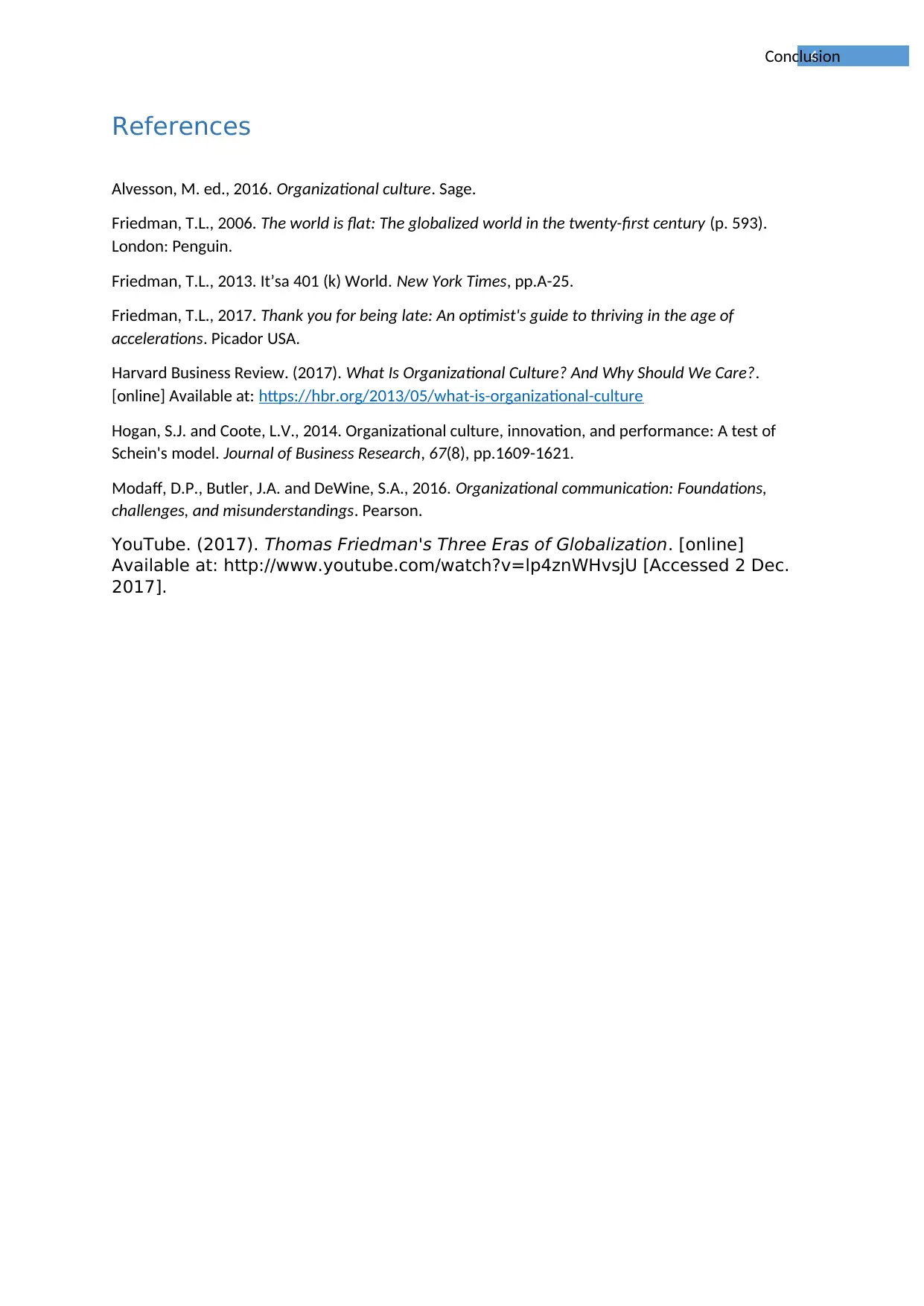
4Conclusion
References
Alvesson, M. ed., 2016. Organizational culture. Sage.
Friedman, T.L., 2006. The world is flat: The globalized world in the twenty-first century (p. 593).
London: Penguin.
Friedman, T.L., 2013. It’sa 401 (k) World. New York Times, pp.A-25.
Friedman, T.L., 2017. Thank you for being late: An optimist's guide to thriving in the age of
accelerations. Picador USA.
Harvard Business Review. (2017). What Is Organizational Culture? And Why Should We Care?.
[online] Available at: https://hbr.org/2013/05/what-is-organizational-culture
Hogan, S.J. and Coote, L.V., 2014. Organizational culture, innovation, and performance: A test of
Schein's model. Journal of Business Research, 67(8), pp.1609-1621.
Modaff, D.P., Butler, J.A. and DeWine, S.A., 2016. Organizational communication: Foundations,
challenges, and misunderstandings. Pearson.
YouTube. (2017). Thomas Friedman's Three Eras of Globalization. [online]
Available at: http://www.youtube.com/watch?v=lp4znWHvsjU [Accessed 2 Dec.
2017].
References
Alvesson, M. ed., 2016. Organizational culture. Sage.
Friedman, T.L., 2006. The world is flat: The globalized world in the twenty-first century (p. 593).
London: Penguin.
Friedman, T.L., 2013. It’sa 401 (k) World. New York Times, pp.A-25.
Friedman, T.L., 2017. Thank you for being late: An optimist's guide to thriving in the age of
accelerations. Picador USA.
Harvard Business Review. (2017). What Is Organizational Culture? And Why Should We Care?.
[online] Available at: https://hbr.org/2013/05/what-is-organizational-culture
Hogan, S.J. and Coote, L.V., 2014. Organizational culture, innovation, and performance: A test of
Schein's model. Journal of Business Research, 67(8), pp.1609-1621.
Modaff, D.P., Butler, J.A. and DeWine, S.A., 2016. Organizational communication: Foundations,
challenges, and misunderstandings. Pearson.
YouTube. (2017). Thomas Friedman's Three Eras of Globalization. [online]
Available at: http://www.youtube.com/watch?v=lp4znWHvsjU [Accessed 2 Dec.
2017].
1 out of 5
Related Documents
Your All-in-One AI-Powered Toolkit for Academic Success.
+13062052269
info@desklib.com
Available 24*7 on WhatsApp / Email
![[object Object]](/_next/static/media/star-bottom.7253800d.svg)
Unlock your academic potential
Copyright © 2020–2025 A2Z Services. All Rights Reserved. Developed and managed by ZUCOL.




